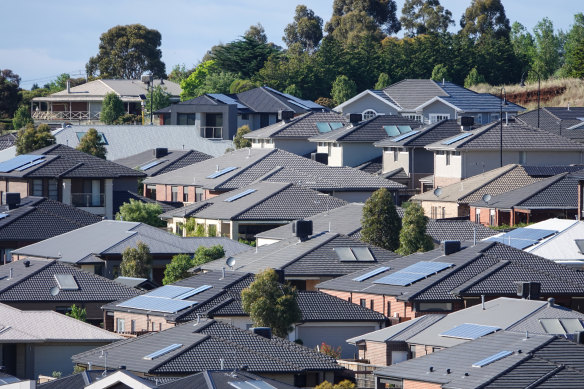By Rachel Clun and Shane Wright
The proportion of households falling behind on their mortgage repayments is rising around the country and is expected to lift further this year as the combination of prolonged high inflation and high interest rates continues to put pressure on budgets.
Moody’s Ratings analysis found home loan arrears were rising in every state and territory and in most local areas, with 30-day delinquency rates more than doubling in some suburbs as households struggle to manage cost-of-living pressures.

Mortgage delinquency rates are rising around the country.Credit: Paul Rovere
Separate figures show inflation remains elevated, rising 0.1 of a percentage point to 3.6 per cent in the 12 months to April, thanks to increases in housing, food, alcohol and transport costs.
The Moody’s Ratings report found regional and outer-suburban areas had higher delinquency rates compared to inner cities because households in those areas had lower disposable incomes, making them more vulnerable to cost-of-living pressures.
Byford in south-east Perth had the highest delinquency rate — 5.33 per cent — but Kingston in Queensland’s Logan region experienced the greatest increase in 30-day delinquencies of the top 10 worst-performing regions, with a rise of 3.16 percentage points to 4.19 per cent.
Six Melbourne suburbs made the top 10, with delinquency rates between 3.57 and 5.01 per cent.
The report noted that in contrast, capital cities, particularly Sydney and Brisbane, had some of the lowest delinquency rates thanks to strong home-value growth and rising incomes.
Alena Chen, vice president and senior credit officer at Moody’s Ratings, said while delinquencies had risen, they remained low by historical standards. Nationally, delinquencies were at 1.72 per cent in November last year, compared with the pre-pandemic rate of 1.82 per cent in November 2019.
“During COVID, there was exceptionally good performance overall, so we are increasing from a low base,” she said. “It is trending up, but it’s going towards more long-term levels.”
Chen said increasing home prices and a strong labour market with an unemployment rate of 4.1 per cent would keep mortgage arrears from rising too quickly, but the prolonged pressure from high interest rates, currently at 4.35 per cent, and high inflation would keep delinquencies rising through the year.
“On the interest rate, there hasn’t been continued 25-[percentage point] increases since November, but it is still relatively high, and high for a large portion of the portfolio of borrowers who might have taken out loans at the bottom of the rate cycle,” she said.
“Inflation has come down, but again, it is still elevated and remains above our long-term average of 2-3 per cent, so those two will continue to be the main things that may put pressure on mortgage repayment over the next year.”
April was the second month in a row where annual inflation lifted slightly, Australian Bureau of Statistics figures showed, increasing from 3.5 per cent in the year to March to 3.6 per cent in the 12 months to April.
The increase in the monthly indication was driven in large part by housing inflation, which rose 4.9 per cent through the year, and food and non-alcoholic beverage inflation, which was up 3.8 per cent.
AMP deputy chief economist Diana Mousina said the data, while volatile, showed the final stretch of getting inflation back down to the Reserve Bank’s target 2-3 per cent range was the hardest.
“While inflation has slowed from its high of 8.4 per cent year-on-year in December 2022, the progress in reducing inflation has stalled in recent months, across both goods and services,” she said.
The Reserve Bank has forecast inflation will rise to 3.8 per cent by June, and Mousina noted the next two months of inflation figures would carry more weight than April’s.
Cut through the noise of federal politics with news, views and expert analysis. Subscribers can sign up to our weekly Inside Politics newsletter.